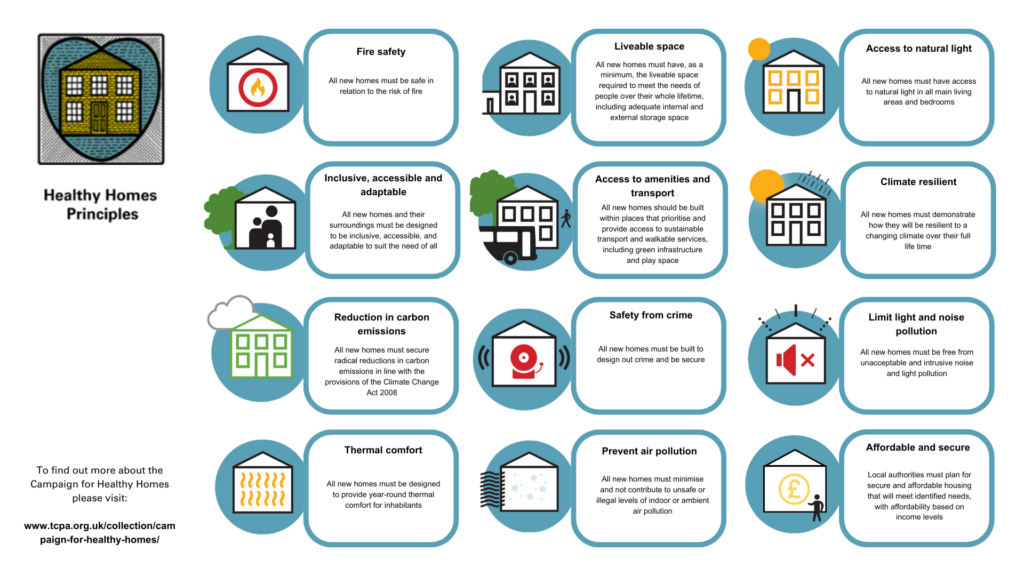To ensure better and more inclusive health outcomes, the TCPA has identified 12 Healthy Homes Principles that all new housing developments must provide. Each month, this blog series explores one of the principles
Healthy Homes Principle: Climate resilient

The growing frequency and severity of extreme weather events due to climate change—including flooding, storms, droughts, overheating, wildfires, and air pollution—pose serious risks to communities (TCPA, 2024 and HSA, 2023). These changes will also exacerbate water and food insecurity and heighten the prevalence of communicable and non-communicable diseases.
To address these challenges, the provision of climate-resilient homes is essential. However, since 2016, approximately 570,000 new homes have been built in England without adequate adaptations to respond to increased temperatures. Additionally, the Environment Agency estimates that 5.7 million properties in England are at risk of flooding, most of which won’t be protected by flood defences (TCPA, 2024).
The Environment Agency estimates that 5.7 million properties in England are at risk of flooding, most of which won’t be protected by flood defences.
The lack of adaptation in the housing stock to climate change (and in the urban realm more generally) brings heavy financial and health costs. The 2022 heatwaves with temperatures above 40 degrees centigrade – resulted in over 3,000 heat-related deaths, the highest level of mortality since the first heatwave plan was written in 2004 (LSE, 2024). The cost to the NHS and society of heat-related mortality is estimated at £6.8 billion every year in the 2020s, and this is projected to rise to £14.7 billion in 2050s (UK Health Security Agency, 2023).
Flooding and storms also have profound impacts, including to the health of people whose homes are affected (Environment Agency, 2021). The issue of climate resilience highlights broader social and health inequalities, with disadvantaged and vulnerable populations facing the worst of these effects. National policies and emergency response need to work not only to mitigate the climate crisis but also to address and reduce the inequalities it exacerbates.
The issue of climate resilience highlights broader social and health inequalities, with disadvantaged and vulnerable populations facing the worst of these effects.
The impact of flooding on health
The most common natural hazard in Europe is flooding, with 50 of the 53 countries in the European region having experienced increased flooding over the last decade, including the UK (European Journal of Public Health, 2020). The increased intensity and frequency of flooding events, whether, from fluvial, tidal, or surface water, highlights the urgent need for enhanced flood and coastal management in response to climate change.
Yet, the latest UK Committee on Climate Change adaptation review (2023) indicated that: ‘Most plans for new developments do not thoroughly regulate or track adaptation for future climate resilience […]. Plans to ensure developments at the coastline are protected remain non statutory, and there is insufficient funding to enable affected communities to adapt’.

Flooding in the Bentley area of Doncaster after a month’s rainfall fell in one day, 2019.
Recent research by the TCPA demonstrates that the planning system is not acting as an effective safeguard to secure flood resilience measures, which can ‘fall through the net’ of regulation due to procedural weaknesses and resource challenges (TCPA, 2024).
Evidence shows the huge burden on placed of people’s physical and mental health from flooding events, both on the short and longer term. The trauma associated with displacement and loss of property raise stress, anxiety and depression in affected individuals, with a lingering long-term fear of flooding happening again (Local Government Association, 2024). As Dr Helen Raison, Consultant in Public Health at Surrey County Council explained:
‘There is a really negative mental health impact in knowing your house might get flooded because of poor planning. This is heightened for people who have had a flood in their home, but also affects those who haven’t.’
Flooding can exacerbate respiratory problems like asthma and bronchitis, due to mould growth in damp homes and the release of airborne pollutants from flooded areas. On a larger scale, flooding can disrupt the functioning of healthcare services with associated infrastructure damage and disrupted transportation systems, making it difficult to provide essential services during and after flooding events (Local Government Association, 2024). More particularly, health inequalities are highlighted in the aftermath of flooding, with vulnerable communities facing the brunt of a flood disaster as they are more likely to reside in low-lying areas.
Heatwaves’ pressure on health
The rising temperatures associated with climate change will lead to more frequent and intense heatwaves, and a potentially dramatic increase in heat-related deaths. Under a high-warming scenario without adaptation, the UK could witness over 21,000 additional heat-related deaths annually by 2070 (UK Health Security Agency, 2023). Young people, individuals with long-term medical conditions and the elderly are the populations the most vulnerable to the effect of hot weather, which increases the risk of strokes, lung illnesses and heart attacks (UK Health Security Agency, 2024). Overall, with evidence that around 20% of homes already overheat even outside of such events. With people spending around 90% of their time indoors the need for climate resilient homes is all the more urgent (UK Climate Risk, 2021).
In addition, these heatwaves are expected to increase the risk of larger and more severe wildfires, potentially extending wildfire season into late summer and autumn. These fires pose significant threat to urban areas, sparking in dried out gardens and grasslands, and spreading to nearby homes. In June 2022, a dozen fires broke out across London as heatwave temperatures soared, and destroyed more than 40 properties (BBC, 2022)
Under a high-warming scenario without adaptation, the UK could witness over 21,000 additional heat-related deaths annually by 2070
Air pollution and climate change
Climate change projections reporting have complex interactions with air quality, but include increased risks from exposure to particulate matter (PM) and Ozone (O3). Ammonia (NH3) emissions associated with agriculture (such as fertiliser application) are also expected to increase due to warming soils. In addition, human exposure to Non Methane Volatile Organic Compounds (NMVOCs – from products such as solvents, air fresheners and cleaning products) is increasingly associated with indoor environments rather than outdoor air, due to their sources and because people spend the majority of their time indoors, including at times of increased heat.
The UK Health Security Agency has called for ‘an integrated approach to the consideration of both outdoor and indoor air quality resulting from climate action’, including careful selection of alternative energy sources (e.g. hydrogen gas boilers), energy retrofit of existing buildings (including enhanced insulation) and nature-based solutions (HSA, 2023).
Climate resilience and permitted development rights
Government guidance exempts conversion of buildings to residential development from conducting flood risk sequential tests. Sequential tests requires proposed sites to be compared to lower-risk alternatives but this is not required for existing buildings. Developers do need to seek prior approval from local authorities to assess the flood risk in certain building types, such as for ‘Class E’ commercial conversions. However, conversion to ‘Class L’ buildings – homes with multiple occupants (HMOs) are exempt.
Overheating considerations in the Building Regulations (Approved Document O) do not currently apply to PD conversions (TCPA,2024). Furthermore, PD conversions do not need to conduct air quality assessments as part of prior approval conditions, where air pollution issues are likely to be exacerbated under future climate change. These omissions raise significant concerns about the climate resilience of housing produced through PD, as they may be more vulnerable to overheating and air pollution risks.
Combining adaptation and mitigation in housing and place
The anticipated health impacts of climate change can be adapted to in UK homes, and in alignment with the net zero agenda. For example, evidence has highlighted the value of Sustainable Drainage Systems for managing flood risk in new developments, as well as wider nature-based solutions, including living walls and roofs (Fox et al, 2022), street trees, and habitat restoration to promote urban cooling, carbon absorption and reduce run off.
Such measures not only enhance resilience to climate risks but also improve mental and physical health, reduce energy costs, and support environmental quality (UK Health Security Agency, 2023). By embedding health priorities into integrated adaptation and mitigation strategies for new housing developments, including measures to improve air quality; passive shading, insulation and ventilation in homes and buildings; clean and active transport; and investment in multi-functional green infrastructure, the UK can achieve significant health benefits and reduce health inequalities.
By embedding health priorities into integrated adaptation and mitigation strategies for new housing developments, the UK can achieve significant health benefits and reduce health inequalities.

Springhill in Stroud is a co-housing development of 35 homes, with SuDs and energy efficient features throughout the site. Collaborative design was applied to integrate climate resilience, landscape ecology and wellbeing objectives (Photo: Robert Bray Associates).
Resources and links:
- Securing Healthy Homes at the local level: a technical guide (TCPA, 2024): tcpa.org.uk/resources/healthy-homes-principles-a-guide-for-local-implementation
- The Climate Crisis: A guide for local authorities on planning for climate change (TCPA, 2023): tcpa.org.uk/resources/the-climate-crisis-a-guide-for-local-authorities-on-planning-for-climate-change
- Delivering flood resilience through the planning system in England (TPCA, 2023): tcpa.org.uk/resources/delivering-flood-resilience-through-the-planning-system-in-england
- The TCPA’s ‘Planning for Flood Risk’ training resources: tcpa.org.uk/planning-for-flood-risk-training
Ensuring all new homes are climate resilient is one of the 12 holistic principles of the Campaign for Healthy Homes. You and your organisation can show your support for these principles by signing up to the Healthy Homes Pledge.




